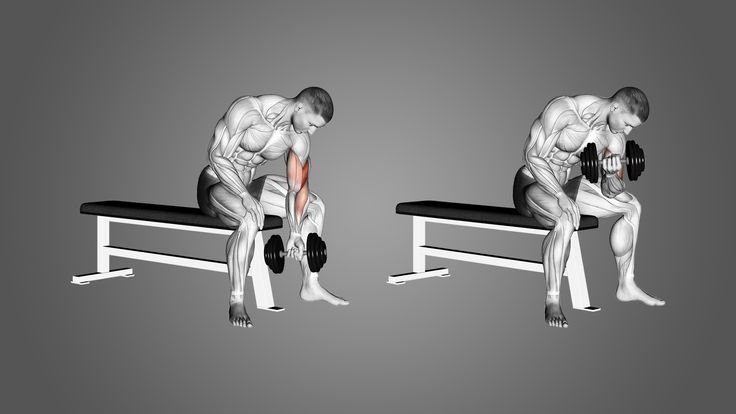8 de April de 2025
Concentration Curls: Exercise Guide, Tips, and Benefits
Concentration curls are a classic isolation exercise targeting the biceps, often featured in strength and conditioning workouts to develop arm shape and definition. By bracing your elbow against your thigh or an upright surface, you minimize momentum and focus on contracting the biceps for a powerful burn. Below, you’ll learn how to perform concentration curls properly, common mistakes to avoid, and how to track your progress using Velocity Based Training (VBT).
What Are Concentration Curls?
Concentration curls involve curling a dumbbell in a controlled manner while the working arm’s elbow is stabilized against the inside of your thigh. This setup helps you concentrate on the biceps by restricting other muscle groups from assisting in the lift. Unlike barbell or standing curls, which can sometimes recruit the shoulders or swing the torso, concentration curls emphasize a strict, isolated contraction.
How to Perform Concentration Curls Properly

- Seated Position
Sit on a bench or chair with your feet firmly on the floor. Spread your knees wide enough to comfortably place one arm inside your thigh. - Starting Position
Hold a dumbbell in one hand and press your elbow into the inside of your thigh. Keep your back straight and chest lifted. - Curl the Weight
Inhale, then exhale as you slowly curl the dumbbell upward toward your shoulder. Focus on squeezing the biceps at the top of the movement. - Lower Under Control
Inhale as you lower the dumbbell back down, maintaining tension in the biceps. Avoid dropping the weight or using momentum. - Switch Arms
Complete your reps on one side, then switch to the other arm to maintain balance.
Muscles Worked by Concentration Curls
- Biceps Brachii: Primary muscle, with the brachialis and brachioradialis assisting
- Forearms: Stabilize the wrist and grip the dumbbell
- Core (to a lesser extent): Helps maintain upright posture and balance during the movement
Because momentum is minimized, the biceps are forced to do most of the work, making this exercise particularly effective for building peak and isolation.

Benefits of Concentration Curls
- Improved Mind-Muscle Connection: Focusing on a single arm encourages better control and contraction.
- Isolation of the Biceps: Reduces shoulder or torso involvement that can occur in other curling exercises.
- Strength and Aesthetics: Regular practice helps develop both size and definition in the upper arms.
- Versatility: Suitable for various fitness levels, as you can adjust the dumbbell weight to match your strength.
Common Mistakes to Avoid
- Jerking the Weight: Keep the movement slow and controlled to prioritize biceps engagement.
- Using Momentum: Relying on body swing or rocking defeats the purpose of an isolation exercise.
- Over-Gripping: While a firm hold is necessary, squeezing the handle too tightly can fatigue your forearms prematurely.
- Poor Posture: Maintain a straight back and stable seated position to avoid lower-back strain.
Variations of Concentration Curls
- Standing Concentration Curl: Brace your elbow against an upright surface (like a squat rack post) if seating isn’t available.
- Cable Concentration Curl: Use a cable machine for constant tension throughout the entire range of motion.
- Tempo Concentration Curl: Focus on a slow eccentric (lowering) phase to maximize time under tension.
Track Your Concentration Curls with Velocity Based Training
Though concentration curls are traditionally executed with moderate or light weight for precise form, you can still apply Velocity Based Training (VBT) principles to gauge performance:
- Set a Baseline Speed: Measure how quickly you can lift a chosen weight for several reps.
- Monitor Fatigue: Notice a drop in bar (or dumbbell) speed mid-set? That’s a sign to rest or reduce load.
- Steady Progress: Consistently track speed over time, aiming to move the weight more explosively or to handle a heavier dumbbell at similar velocity.
Using VBT tools such as linear encoders for isolation exercises can help you fine-tune technique, prevent premature fatigue, and ensure steady strength gains.
FAQs About Concentration Curls
Are concentration curls better than barbell curls?
They’re not necessarily “better,” but they serve a different purpose. Barbell curls let you lift heavier weight and target overall strength; concentration curls focus on isolation and precise muscle engagement.
Should concentration curls be heavy or light?
Most exercisers opt for moderate to light weight to maintain strict form and maximize biceps isolation. Going too heavy can lead to swinging or incomplete range of motion.
Which is better, hammer curls or concentration curls?
They target the biceps from slightly different angles. Hammer curls emphasize the brachialis and forearms, while concentration curls heavily isolate the biceps brachii. Both can coexist in a well-rounded arm routine.
Which bicep curl is most effective?
“Most effective” varies by goal. Barbell and dumbbell curls build overall size and strength; concentration curls excel at isolation and peak contraction. Incorporate multiple curl variations for optimal development.
What exercise hits all three bicep heads?
Exercises like hammer curls and EZ-bar curls can emphasize all portions of the biceps brachii, including the long, short, and brachialis components. However, no single exercise perfectly targets every head equally.
What is the number 1 best bicep exercise?
There’s no universal “best.” Many lifters consider barbell or dumbbell curls the primary go-to for bicep growth. That said, a combination of different curling variations—concentration curls included—often yields the best results.
Concentration curls offer a unique, focused method to build bicep strength and definition. Whether you’re incorporating them into a broader strength and conditioning routine or simply want to refine your arm training, practicing proper form and considering velocity-based insights can enhance both performance and results.
